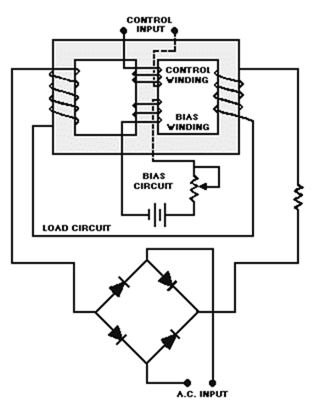SIMPLIFIED MAGNETIC AMPLIFIER CIRCUITRY
If the saturable-core reactor works, why do we need to add a rectifier to produce a magnetic amplifier? To answer this question, recall that in NEETS, module 2 – Introduction to Alternating Current and Transformers, you were told about hysteresis loss. Hysteresis loss occurs because the a.c. applied to a coil causes the tiny molecular magnets (or electron-spin directions) to realign as the polarity of the a.c. changes. This realignment uses up power. The power that is used for realignment is a loss as far as the rest of the circuit is concerned. Because of this hysteresis loss in the saturable-core reactor, the power gain is relatively low. A rectifier added to the load circuit will eliminate the hysteresis loss and increase the gain. This is because the rectifier allows current to flow in only one direction through the load coils.
A simple half-wave magnetic amplifier is shown in figure 3-38. This is a half-wave magnetic amplifier because it uses a half-wave rectifier. During the first half cycle of the load voltage, the diode conducts and the load windings develop load flux as shown in view (A) by the dashed-line arrows. The load flux from the two load coils cancels and has no effect on the control flux. During the second half cycle, the diode does not conduct and the load coils develop no flux, as shown in view (B). The load flux never has to reverse direction as it did in the saturable-core reactor, so the hysteresis loss is eliminated.
Figure 3-38A. – Simple half-wave magnetic amplifier. FIRST HALF CYCLE
Figure 3-38B. – Simple half-wave magnetic amplifier. SECOND HALF CYCLE

The circuit shown in figure 3-38 is only able to use half of the load voltage (and therefore half the possible load power) since the diode blocks current during half the load-voltage cycle. A full-wave rectifier used in place of CR1 would allow current flow during the entire cycle of load voltage while still preventing hysteresis loss.
Figure 3-39 shows a simple full-wave magnetic amplifier. The bridge circuit of CR1, CR2, CR3, CR4 allows current to flow in the load circuit during the entire load voltage cycle, but the load current is always in the same direction. This current flow in one direction prevents hysteresis loss.
View (A) shows that during the first half cycle of load voltage, current flows through CR1, the load coils, and CR3. View (B) shows that during the second half cycle, load current flows through CR2, the load coils, and CR4.
Figure 3-39A. – Simple full-wave magnetic amplifier. FIRST HALF CYCLE

Figure 3-39B. – Simple full-wave magnetic amplifier. SECOND HALF CYCLE

Up to this point, the control circuit of the magnetic amplifier has been shown with d.c. applied to it. Magnetic-amplifier control circuits should accept a.c. input signals as well as d.c. input signals. As shown earlier in figure 3-34, a saturable-core reactor has an ideal operating point. Some d.c. must always be applied to bring the saturable core to that operating point. This d.c. is called BIAS. the most effective way to apply bias to the saturable core and also allow a.c. input signals to control the magnetic amplifier is to use a bias winding. A full-wave magnetic amplifier with a bias winding is shown in figure 3-40.
Figure 3-40. – Full-wave magnetic amplifier with bias winding.

In the circuit shown in figure 3-40, the bias circuit is adjusted to set the saturable-core reactor at the ideal operating point. Input signals, represented by the a.c. source symbol, are applied to the control input. The true power of the load circuit is controlled by the control input signal (a.c.)
The block diagram symbol for a magnetic amplifier is shown in figure 3-41. The triangle is the general symbol for an amplifier. The saturable-core reactor symbol in the center of the triangle identifies the amplifier as a magnetic amplifier. Notice the input and output signals shown. The input signal is a small-amplitude, low-power a.c. signal. The output signal is a pulsating d.c. with an amplitude that varies. This variation is controlled by the input signal and represents a power gain of 1000.
Figure 3-41. – Magnetic amplifier input and output signals.

Some magnetic amplifiers are designed so a.c. goes through the load rather than pulsating d.c. This is done by placing the load in a different circuit position with respect to the rectifier. The principle of the magnetic amplifier remains the same: Control current still controls load current.
Magnetic amplifiers provide a way of accurately controlling large amounts of power. They are used in servosystems (which are covered later in this training series), temperature or pressure indicators, and power supplies.
This chapter has presented only the basic operating theory of saturable-core reactors and magnetic amplifiers. For your convenience, simple schematic diagrams have been used to illustrate this material. When magnetic amplifiers and saturable-core reactors are used in actual equipment, the schematics may be more complex than those you have seen here. Also, you may find coils used in addition to those presented in this chapter. The technical manual for the equipment in question should contain the information you need to supplement what you have read in this chapter.
Q.46 At what portion of the magnetization curve should a magnetic amplifier be operated?
Q.47 How is the effect of load flux on control flux eliminated in a saturable-core reactor?
Q.48 What is the purpose of the rectifier in a magnetic amplifier?
Q.49 What is used to bias a magnetic amplifier so that the control winding remains free to accept control (input) signals?
Q.50 List two common usages of magnetic amplifiers.
Back
Home
Up
Next
SUMMARY OF SPECIAL AMPLIFIERS
This chapter has presented information on differential amplifiers, operational amplifiers, and magnetic amplifiers. The information that follows summarizes the important points of this chapter.
A DIFFERENCE AMPLIFIER is any amplifier with an output signal dependent upon the difference between the input signals. A two-input, single-output difference amplifier can be made by combining the common-emitter and common-base configurations in a single transistor.

A difference amplifier can have input signals that are IN PHASE with each other, 180 DEGREES OUT OF PHASE with each other, or OUT OF PHASE BY SOMETHING OTHER THAN 180 DEGREES with each other.

A DIFFERENTIAL AMPLIFIER has two possible inputs and two possible outputs. The combined output signal is dependent upon the difference between the input signals.

A differential amplifier can be configured with a SINGLE INPUT and a SINGLE OUTPUT 
a SINGLE INPUT and a DIFFERENTIAL OUTPUT

or a DIFFERENTIAL INPUT and a DIFFERENTIAL OUTPUT.
 An OPERATIONAL AMPLIFIER is an amplifier which has very high gain, very high input impedance, and very low output impedance. An OP AMP is made from three stages: (1) a differential amplifier, (2) a high-gain voltage amplifier, and (3) an output amplifier.
An OPERATIONAL AMPLIFIER is an amplifier which has very high gain, very high input impedance, and very low output impedance. An OP AMP is made from three stages: (1) a differential amplifier, (2) a high-gain voltage amplifier, and (3) an output amplifier.

Operational amplifiers are usually used in a CLOSED-LOOP OPERATION. This means that degenerative feedback is used to lower the gain and increase the stability of the operational amplifier.
An operational amplifier circuit can be connected with an INVERTING CONFIGURATION

or a NONINVERTING CONFIGURATION.

The GAIN-BANDWIDTH PRODUCT for an operational amplifier is computed by multiplying the gain by the bandwidth (in hertz). For any given operational amplifier, the gain-bandwidth product will remain the same regardless of the amount of feedback used.

A SUMMING AMPLIFIER is an application of an operational amplifier in which the output signal is determined by the sum of the input signals multiplied by the gain of the amplifier:
![]()

A SCALING AMPLIFIER is a special type of summing amplifier with the output signal determined by multiplying each input signal by a different factor (determined by the ratio of the input-signal resistor and feedback resistor) and then adding these products:
A DIFFERENCE AMPLIFIER is an application of an operational amplifier in which the output signal is determined by the difference between the input signals multiplied by the gain of the amplifier:
A SATURABLE-CORE REACTOR works upon the principle that increasing the current through a coil decreases the permeability of the core; the decreased permeability decreases the inductance of the coil which causes an increase in current (power) through the load.
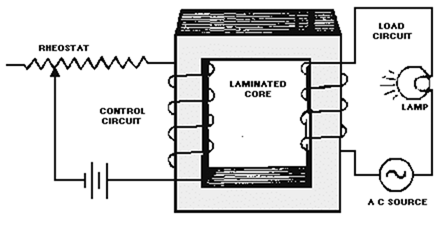
THE IDEAL OPERATING POINT of a saturable-core reactor is on the KNEE OF THE MAGNETIZATION CURVE. At this point, small changes in control current will cause large changes in load current (power).
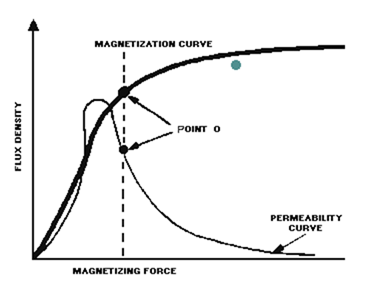
THREE-LEGGED and TOROIDAL saturable-core reactors solve the problem of load flux aiding and opposing control flux during alternate half cycles of the a.c. load current. 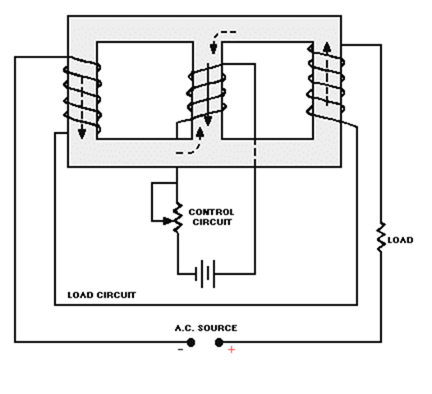
MAGNETIC AMPLIFIERS use the principle of electromagnetism to amplify signals. They are power amplifiers with a Frequency response normally limited to 100 hertz or below. Magnetic amplifiers use a saturable-core reactor. A magnetic amplifier uses a RECTIFIER to solve the problem of HYSTERESIS LOSS in a saturable-core reactor.
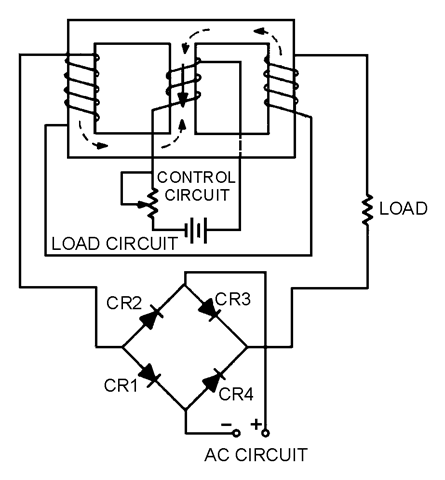
A BIAS WINDING allows a d.c. bias voltage to be applied to the saturable-core reactor while a.c. control signals are applied to a separate control winding. In this way a magnetic amplifier can be set to the proper operating point.
ANSWERS TO QUESTIONS Q1. THROUGH Q50.
A1. Two inputs, two outputs.
A2. Common emitter (CE) and common base (CB).
A3. No output (the signals will "cancel out").
A4. Equal in shape and frequency to each input signal and larger in amplitude by two times than either input signal.
A5. Equal in shape and frequency to the input signal; larger in amplitude than the input signal; half as large in amplitude as when two input signals were used that were 180 degrees out of phase.
A6. A different shape than the input signals but larger in amplitude.
A7. 100 millivolts.
A8. Each output will be a sine wave with a peak-to-peak amplitude of 100 millivolts. The output signals will be 180 degrees out of phase with each other.
A9. 200 millivolts. A10. 0 volts (the input signals will "cancel out").
A11. Each output signal will be 100 millivolts.
A12.
-
a: 180 degrees out of phase with each other.
-
b: Output signal number one will be in phase with input signal number two; output signal number two will be in phase with input signal number one.
A13. 200 millivolts.
A14.
-
a. 100 millivolts.
-
b. No.
A15. Very high gain, very high input impedance, very low output impedance.
A16. An integrated circuit (chip).
-
a. Differential amplifier.
-
b. Voltage amplifier.
-
c. Output amplifier.
A19. The use of degenerative (negative) feed-back.
A20. Both the input signal and the feedback signal.
A21. Inverting. Inverting.
A22. 0 volts.
A23. Virtual.
A24. -50 millivolts.
A25. 50 kilohertz (Gain = 10; Gain- Bandwidth Product = 500,000;
A27. 1 megahertz.
Open-loop Gain-Bandwidth Product = Closed-loop Gain-Bandwidth Prod.
Open-loop Gain-Bandwidth Product = 200,000 X 30 (Hz)
Open-loop Gain Bandwidth Product = 600,000
Closed-loop Gain Bandwidth Product = 6 X Bandwidth
6,000,000 = 6 X Bandwidth
1,000,000 (Hz) = Bandwidth
A28. The adder simply adds the input signals together while the summing amplifier multiplies the sum of the input signals by the gain of circuit.
A29. Yes, a summing amplifier can have as many inputs as desired.
A30. A summing amplifier that applies a factor to each input signal beforeadding the results.
A31. A scaling amplifier.
A32.
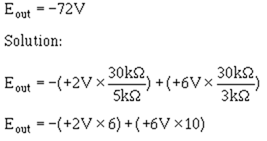
A33. 0 volts. (The two inputs to the operational amplifier are both at 0 volts.)
A34. The difference amplifier multiplies the difference between the two inputs by the gain of the circuit while the subtractor merely subtracts one input signal from the other.
A35. No.
A36. A difference amplifier.
A37.

A38. 0 volts. (The two inputs to the operational amplifier are both at the same potential.)
A39. An audio (or low) frequency power amplifier.
A40. A change in inductance in a series LR circuit causes a change in true power.
A41. It decreases.
A42. (a) Inductance increases; (b) true power decreases.
A43. Permeability decreases.
A44. A change in inductance.
A45.
A47. Use two load windings whose flux effects cancel in the core of the reactor or use two load windings on two toroidal cores so that load flux always aids control flux in one core and opposes control flux in the other core.
A48. The rectifier eliminates hysteresis loss.
A49. A bias winding and associated circuitry.
A50. Servosystems, temperature recorders, or power supplies.
Back
Home
Up







